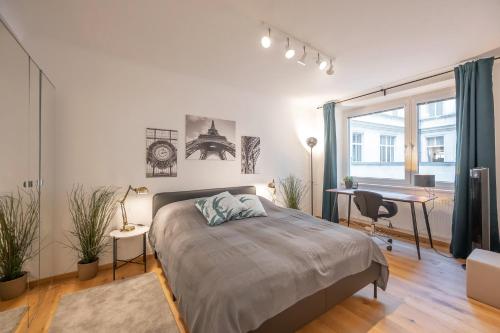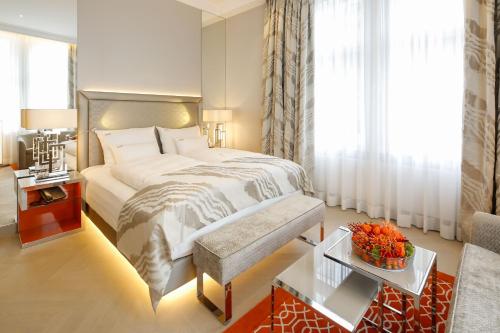The Historic Centre of Vienna, Austria
As I glide along the road, past a Baroque palace on one side and an elegant park on the other, I have no regrets about the choice I have made today.
Rather than walk, or use public transport, I’ve decided to explore the historic centre of Vienna by bicycle – and it turns out the Austrian capital lends itself to cycling.
It’s not just the bike paths that you find through Vienna, taking you out on arterial roads to different parts of the city, and allowing you to circle around the centre.
Although they certainly make it very convenient and safe to cycle, which makes the experience stress-free when coupled with the respect that motorists seem to show to those on just two wheels.
Although I do it independently, there is an excellent bike tour of Vienna that would also be a great way to explore the city.
It’s also that the city seems to have something new to look at every few metres. The entire historic centre is like a gallery of exquisite buildings, parks, and grand boulevards. I want to stop constantly and look at things, take photos, admire their magnificence.
If I was in a car, a bus, a tram, then I’m sure I would be rushed past some of the things that I want to observe for a bit longer. If I was walking, I’m not sure I would get to them all.
It’s also worth noting that I’ve even been able to use the bike to ride out to Schonbrunn Palace, about six kilometres from the centre of Vienna, saving me time and giving me another view of what has been declared the world’s most liveable city.
Schonbrunn Palace is also a World Heritage Site – separate from the Historic Centre of Vienna – and it’s definitely worth visiting. To get more out of your visit, I would recommend a guided tour of the palace.
And it’s also been very easy to borrow the bike for free from the Avalon river cruise that I’ve arrived in Vienna on – and you can read more about Avalon’s Active and Discovery itineraries here.
But back to the historic centre of Vienna, this incredible collection of architecture and history that has, in its entirety, been named as a World Heritage Site.
Developed from early Celtic and Roman settlements into a Medieval and Baroque city, it exudes the wealth you would expect from the former capital of the Austro-Hungarian Empire.
But it wasn’t just about money and power. More than most other major political centres, Vienna also cultivated the arts, playing a leading role as a European music centre from the age of Viennese Classicism through to the early part of the 20th century.
And all of this is on display in the Baroque castles and palaces, the imposing churches, the grand buildings along the Ringstrasse, and the monuments, squares, and parks that give texture to the collection of architectural masterpieces.
It’s these elements, all of them taken together – the artistic and the physical – that define the World Heritage Site of Vienna’s historic centre. But now it’s under threat.
UNESCO World Heritage in Danger List
UNESCO has placed the Historic Centre of Vienna on the ‘World Heritage in Danger List’, a collection of sites that are under threat from something that could seriously damage the core of why a location is a World Heritage Site.
There are currently 53 sites on the World Heritage in Danger List, many of them threatened by war, like the 2 in Afghanistan, the 6 in Syria, the 3 in Yemen.
Others are under threat from environmental concerns, like Indonesia’s Rainforest of Sumatra, Peru’s Chan Chan ruins, and the Rio Platano Biosphere Reserve in Honduras.
And there are those that are in danger because of major development nearby, like mining near Bolivia’s City of Potosi, a new dam near Kenya’s Lake Turkana National Park, and logging near East Rennell in the Solomon Islands.
Vienna on the World Heritage in Danger List
So what is threatening the Historic Centre of Vienna so badly that UNESCO has taken this action in Austria?
Well, it’s a proposal for a new hotel.
The project that’s been proposed is called the ‘Vienna Ice-Skating Club – Intercontinental Hotel’ and it’s a large complex that would be about 6500 square metres. It would have an indoor skating rink, open air public areas, a conference centre, and a hotel and luxury apartments in a tower.
It’s the tower in particular that is causing the problem. The proposed height of it, at 66.3 metres, is taller than UNESCO’s restriction of 43 metres. It’s already been revised down from 75 metres because of opposition.
I actually think it’s a very interesting issue but it’s not nearly as clear cut as most of the other World Heritage Sites that are listed as ‘in danger’.
There are many locals and officials who think the development in Vienna would be a good thing – that it would be an attractive complex, offering public facilities, that has taken into consideration the architectural style of the city.
It wouldn’t be hard to improve on what’s currently there!
UNESCO’s perspective is that there need to be strict rules or a development like this could be the thing edge of the wedge. Once one tower is built over the height regulations, even if it is attractive, more may follow and they may not be as sympathetic in style.
The debate has now got to the point where locals who may not be against this particular development are now campaigning against it because they don’t want to lose the World Heritage Site designation, which could loosen the restrictions for future buildings.
The issue raises a bigger question of how World Heritage should fit together with major urban centres.
It’s very easy to protect an archaeological site or a national park that has a clear border. But when a World Heritage Site is an entire city centre like Vienna, where hundreds of thousands of people live and work, and there is an understandable need to evolve over time, it’s not so simple.
Can you really tell a European capital city that it can’t construct new buildings, holding it back from competing with other major economic centres?
Perhaps it’s not a surprise that the Austrian and Viennese authorities are considering delisting the Historic Centre of Vienna as a World Heritage Site, freeing them up for the modern developments that may be needed now and in the generations to come.
For now, though, the project is stalled and it’s not clear what the outcome will be. For visitors, it makes very little difference – the centre of Vienna is still as remarkable as it was when it was first added to the World Heritage List.
What to see in the Historic Centre of Vienna
I see that for myself, starting at the modern Museum Quarter in the former Imperial Stables and heading through Maria-Theresien Platz with the striking Natural History Museum and Art History Museum on either side.
If you are interested in seeing this area in detail, there’s a great guided tour of the Museum Quarter.
From here, I cross over the Ringstrasse, which is the Burgring at this point. I will come back to the Ringstrasse many times as I explore Vienna and cycling along its length is a fantastic way to see the city.
This grand boulevard that was built in the middle of the 19th century to replace the city walls has some of the most important and impressive buildings of the city along it.
But, for now, I cycle instead through the Outer Castle Gate and into Heldenplatz, past the Neue Burg extension of the Imperial Palace that now houses three museums.
The Imperial Palace, known as the Hofburg, is one of the largest palace complexes in the world and it would be easy to spend days seeing its various museums and monuments.
Instead, I cycle out through the enormous entrance gate known as the Michaelertor and under the great copper dome called the Michaelerkuppel, and into the dense collection of Baroque buildings that make up the centre of the city.
I wind through the streets until I reach the most iconic of the buildings in the centre (after the Hofburg), St Stephen’s Cathedral. This version of the church was built in the 14th century and it’s the colourful tiles on the roof that catch my attention first.
The spire of St Stephen’s is 136 metres. It’s hard to imagine that a new hotel tower, even one at 66.3 metres, would threaten its status. In fact, exploring Vienna, I don’t think a new hotel would take away from any of these historic buildings.
It’s good that we have organisations like UNESCO that are protecting our heritage – perhaps the city would not still look like this if it was not for regulations and restrictions. But, at the same time, we need to accept that everything here was new once.
As long as Vienna respects style and history alongside the need to evolve and innovate, this will remain one of the most beautiful capital cities in Europe.
I would recommend taking your time to explore Vienna and, although you can obviously walk around by yourself, there are some excellent local guides that will show you much more than you’ll see on your own.
If there’s a group of you, this private tour is good value. Otherwise, there are some great options here:
THE BEST ACCOMMODATION IN VIENNA
Although accommodation in the 1st District puts you in the heart of the action, I’ve got more tips on where to stay in Vienna if you want to explore other neighbourhoods.
BACKPACKER

The dorm rooms are standard, but Wombat’s City Hostel Vienna Naschmarkt has such a fun atmosphere and really cool common areas.
APARTMENT

If you would like your own space, Modern City Center Apartment is clean and comfortable, with two bedrooms and a full kitchen.
BOUTIQUE

Not only is the location perfect, but Boutiquehotel Das Tyrol has a gorgeous interior full of colour, plus excellent dining.
LUXURY

As Vienna’s oldest hotel, you’ll feel the heritage at Hotel Stefanie even though it’s had a modern makeover with opulent touches.